Criminal Justice & Criminology: Victims and Vulnerability Essay
VerifiedAdded on 2023/05/29
|5
|1439
|286
Essay
AI Summary
This essay provides a summary and descriptive overview of victims and vulnerability in the criminal justice system, examining how social conditions explain these concepts. It argues that the development of victimisation and vulnerability serves political and economic interests, highlighting the lack of attention given to vulnerable groups in previous research due to biased debates and policies. The essay reconsiders the ‘ideal victim’ concept, vulnerability, and crime measurement, referencing Christie's notions of an ideal victim and Spalek's insights on deserving victims. It discusses vulnerability in relation to the fear of crime, physical and social factors, and the risk exposure of different groups, while also addressing the impact of gender, ethnicity, and economic status on vulnerability. The essay concludes by emphasizing the need for further research on the relationship between economic status and vulnerability.
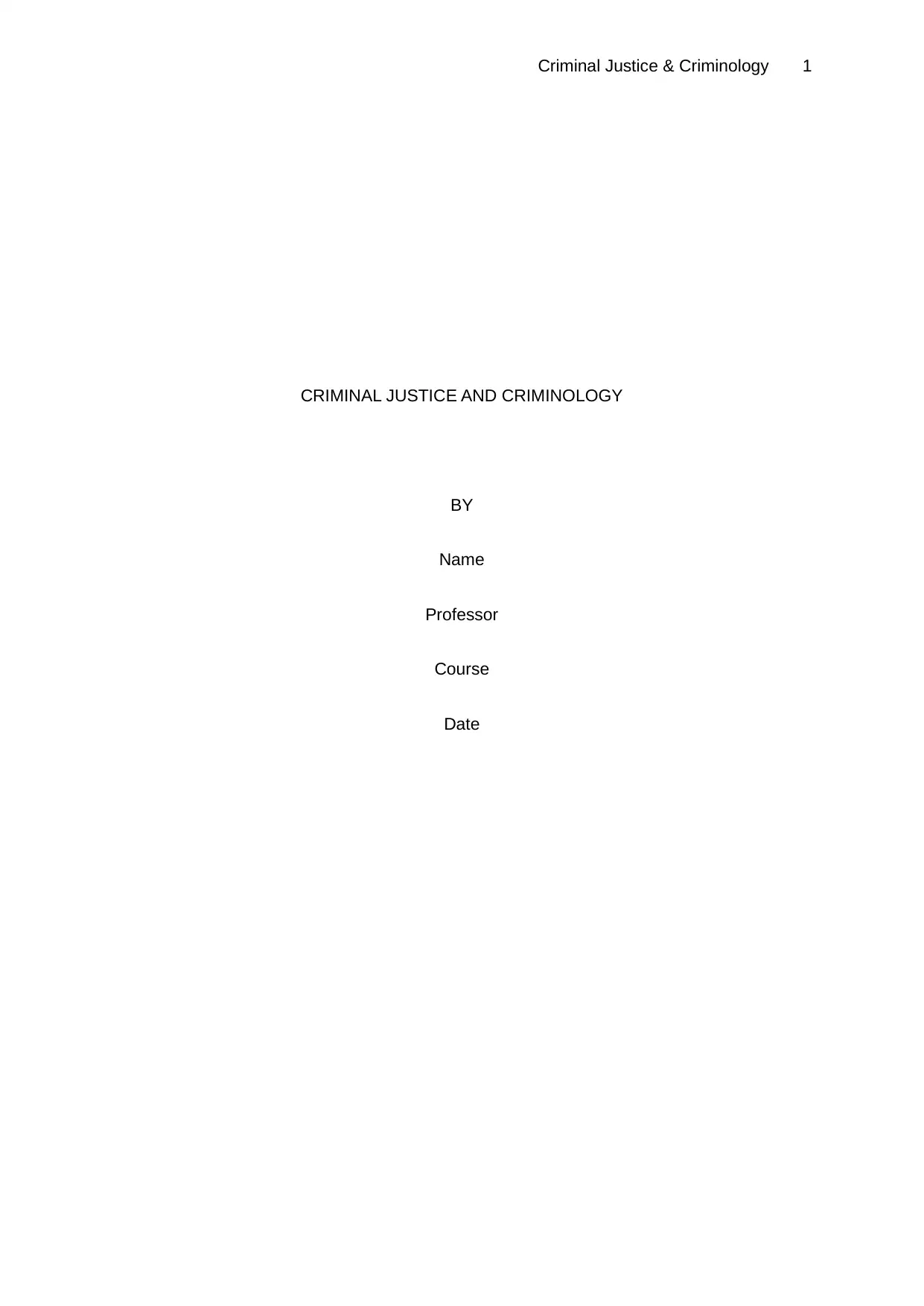
Criminal Justice & Criminology 1
CRIMINAL JUSTICE AND CRIMINOLOGY
BY
Name
Professor
Course
Date
CRIMINAL JUSTICE AND CRIMINOLOGY
BY
Name
Professor
Course
Date
Paraphrase This Document
Need a fresh take? Get an instant paraphrase of this document with our AI Paraphraser
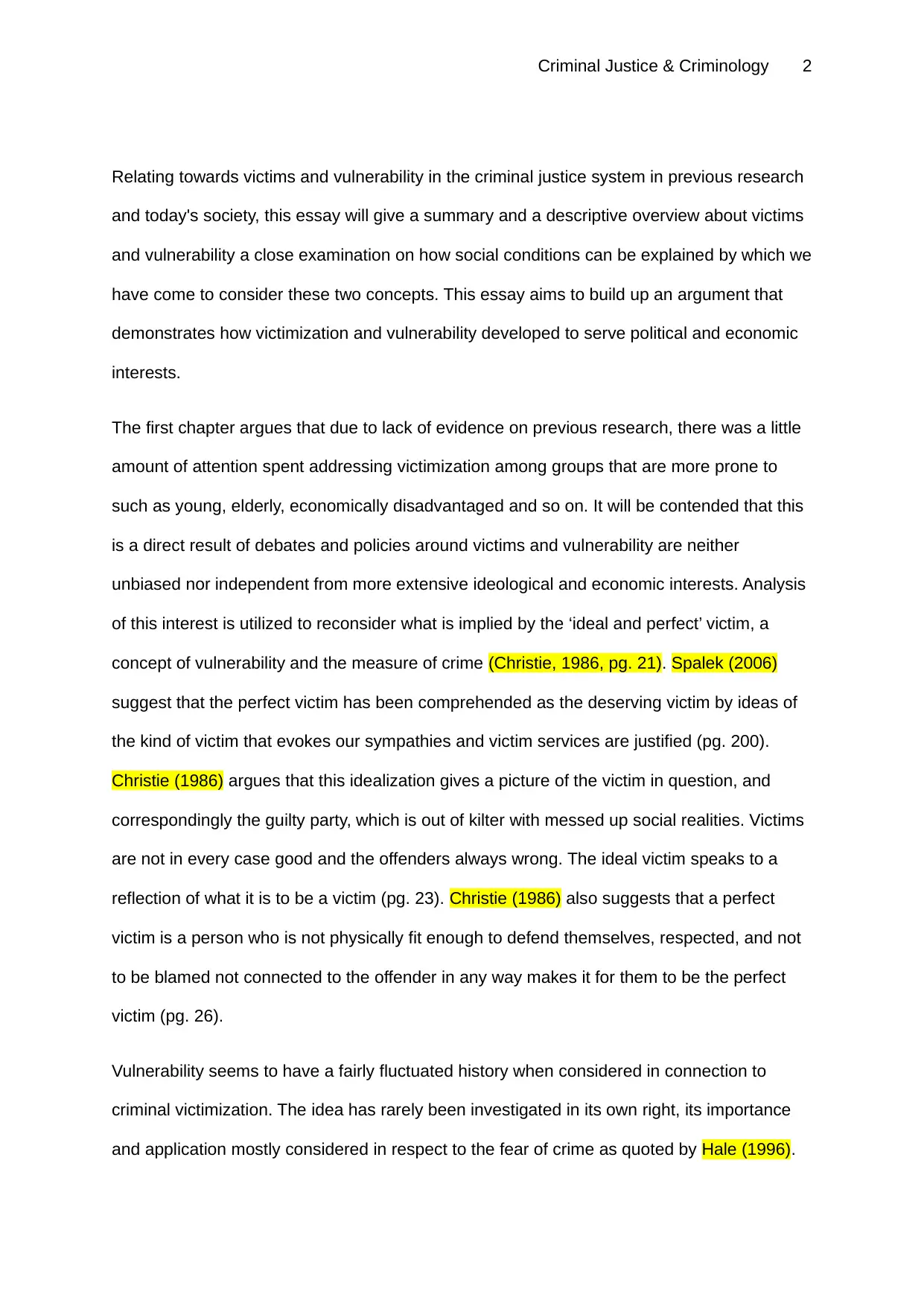
Criminal Justice & Criminology 2
Relating towards victims and vulnerability in the criminal justice system in previous research
and today's society, this essay will give a summary and a descriptive overview about victims
and vulnerability a close examination on how social conditions can be explained by which we
have come to consider these two concepts. This essay aims to build up an argument that
demonstrates how victimization and vulnerability developed to serve political and economic
interests.
The first chapter argues that due to lack of evidence on previous research, there was a little
amount of attention spent addressing victimization among groups that are more prone to
such as young, elderly, economically disadvantaged and so on. It will be contended that this
is a direct result of debates and policies around victims and vulnerability are neither
unbiased nor independent from more extensive ideological and economic interests. Analysis
of this interest is utilized to reconsider what is implied by the ‘ideal and perfect’ victim, a
concept of vulnerability and the measure of crime (Christie, 1986, pg. 21). Spalek (2006)
suggest that the perfect victim has been comprehended as the deserving victim by ideas of
the kind of victim that evokes our sympathies and victim services are justified (pg. 200).
Christie (1986) argues that this idealization gives a picture of the victim in question, and
correspondingly the guilty party, which is out of kilter with messed up social realities. Victims
are not in every case good and the offenders always wrong. The ideal victim speaks to a
reflection of what it is to be a victim (pg. 23). Christie (1986) also suggests that a perfect
victim is a person who is not physically fit enough to defend themselves, respected, and not
to be blamed not connected to the offender in any way makes it for them to be the perfect
victim (pg. 26).
Vulnerability seems to have a fairly fluctuated history when considered in connection to
criminal victimization. The idea has rarely been investigated in its own right, its importance
and application mostly considered in respect to the fear of crime as quoted by Hale (1996).
Relating towards victims and vulnerability in the criminal justice system in previous research
and today's society, this essay will give a summary and a descriptive overview about victims
and vulnerability a close examination on how social conditions can be explained by which we
have come to consider these two concepts. This essay aims to build up an argument that
demonstrates how victimization and vulnerability developed to serve political and economic
interests.
The first chapter argues that due to lack of evidence on previous research, there was a little
amount of attention spent addressing victimization among groups that are more prone to
such as young, elderly, economically disadvantaged and so on. It will be contended that this
is a direct result of debates and policies around victims and vulnerability are neither
unbiased nor independent from more extensive ideological and economic interests. Analysis
of this interest is utilized to reconsider what is implied by the ‘ideal and perfect’ victim, a
concept of vulnerability and the measure of crime (Christie, 1986, pg. 21). Spalek (2006)
suggest that the perfect victim has been comprehended as the deserving victim by ideas of
the kind of victim that evokes our sympathies and victim services are justified (pg. 200).
Christie (1986) argues that this idealization gives a picture of the victim in question, and
correspondingly the guilty party, which is out of kilter with messed up social realities. Victims
are not in every case good and the offenders always wrong. The ideal victim speaks to a
reflection of what it is to be a victim (pg. 23). Christie (1986) also suggests that a perfect
victim is a person who is not physically fit enough to defend themselves, respected, and not
to be blamed not connected to the offender in any way makes it for them to be the perfect
victim (pg. 26).
Vulnerability seems to have a fairly fluctuated history when considered in connection to
criminal victimization. The idea has rarely been investigated in its own right, its importance
and application mostly considered in respect to the fear of crime as quoted by Hale (1996).
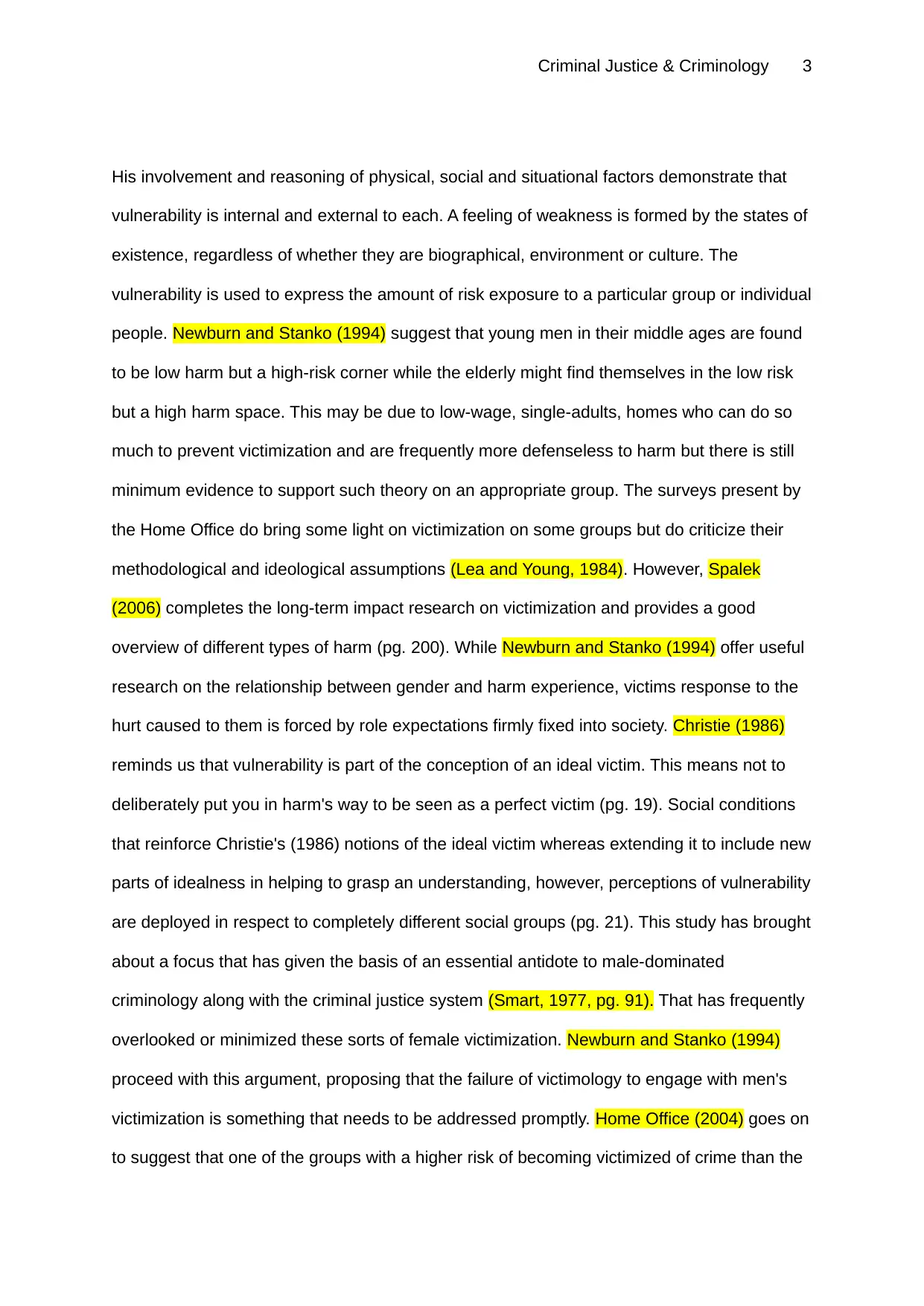
Criminal Justice & Criminology 3
His involvement and reasoning of physical, social and situational factors demonstrate that
vulnerability is internal and external to each. A feeling of weakness is formed by the states of
existence, regardless of whether they are biographical, environment or culture. The
vulnerability is used to express the amount of risk exposure to a particular group or individual
people. Newburn and Stanko (1994) suggest that young men in their middle ages are found
to be low harm but a high-risk corner while the elderly might find themselves in the low risk
but a high harm space. This may be due to low-wage, single-adults, homes who can do so
much to prevent victimization and are frequently more defenseless to harm but there is still
minimum evidence to support such theory on an appropriate group. The surveys present by
the Home Office do bring some light on victimization on some groups but do criticize their
methodological and ideological assumptions (Lea and Young, 1984). However, Spalek
(2006) completes the long-term impact research on victimization and provides a good
overview of different types of harm (pg. 200). While Newburn and Stanko (1994) offer useful
research on the relationship between gender and harm experience, victims response to the
hurt caused to them is forced by role expectations firmly fixed into society. Christie (1986)
reminds us that vulnerability is part of the conception of an ideal victim. This means not to
deliberately put you in harm's way to be seen as a perfect victim (pg. 19). Social conditions
that reinforce Christie's (1986) notions of the ideal victim whereas extending it to include new
parts of idealness in helping to grasp an understanding, however, perceptions of vulnerability
are deployed in respect to completely different social groups (pg. 21). This study has brought
about a focus that has given the basis of an essential antidote to male-dominated
criminology along with the criminal justice system (Smart, 1977, pg. 91). That has frequently
overlooked or minimized these sorts of female victimization. Newburn and Stanko (1994)
proceed with this argument, proposing that the failure of victimology to engage with men's
victimization is something that needs to be addressed promptly. Home Office (2004) goes on
to suggest that one of the groups with a higher risk of becoming victimized of crime than the
His involvement and reasoning of physical, social and situational factors demonstrate that
vulnerability is internal and external to each. A feeling of weakness is formed by the states of
existence, regardless of whether they are biographical, environment or culture. The
vulnerability is used to express the amount of risk exposure to a particular group or individual
people. Newburn and Stanko (1994) suggest that young men in their middle ages are found
to be low harm but a high-risk corner while the elderly might find themselves in the low risk
but a high harm space. This may be due to low-wage, single-adults, homes who can do so
much to prevent victimization and are frequently more defenseless to harm but there is still
minimum evidence to support such theory on an appropriate group. The surveys present by
the Home Office do bring some light on victimization on some groups but do criticize their
methodological and ideological assumptions (Lea and Young, 1984). However, Spalek
(2006) completes the long-term impact research on victimization and provides a good
overview of different types of harm (pg. 200). While Newburn and Stanko (1994) offer useful
research on the relationship between gender and harm experience, victims response to the
hurt caused to them is forced by role expectations firmly fixed into society. Christie (1986)
reminds us that vulnerability is part of the conception of an ideal victim. This means not to
deliberately put you in harm's way to be seen as a perfect victim (pg. 19). Social conditions
that reinforce Christie's (1986) notions of the ideal victim whereas extending it to include new
parts of idealness in helping to grasp an understanding, however, perceptions of vulnerability
are deployed in respect to completely different social groups (pg. 21). This study has brought
about a focus that has given the basis of an essential antidote to male-dominated
criminology along with the criminal justice system (Smart, 1977, pg. 91). That has frequently
overlooked or minimized these sorts of female victimization. Newburn and Stanko (1994)
proceed with this argument, proposing that the failure of victimology to engage with men's
victimization is something that needs to be addressed promptly. Home Office (2004) goes on
to suggest that one of the groups with a higher risk of becoming victimized of crime than the
⊘ This is a preview!⊘
Do you want full access?
Subscribe today to unlock all pages.

Trusted by 1+ million students worldwide
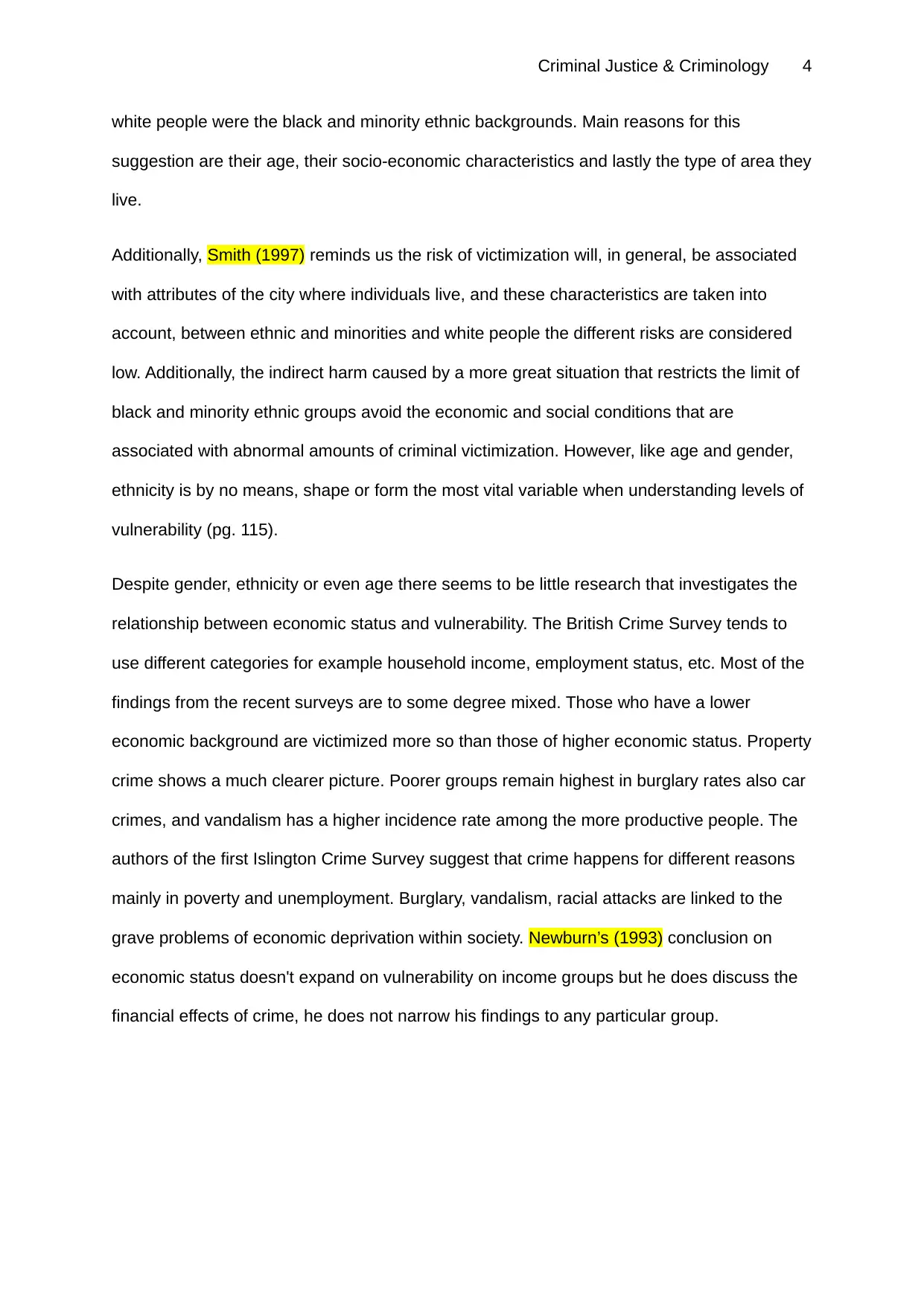
Criminal Justice & Criminology 4
white people were the black and minority ethnic backgrounds. Main reasons for this
suggestion are their age, their socio-economic characteristics and lastly the type of area they
live.
Additionally, Smith (1997) reminds us the risk of victimization will, in general, be associated
with attributes of the city where individuals live, and these characteristics are taken into
account, between ethnic and minorities and white people the different risks are considered
low. Additionally, the indirect harm caused by a more great situation that restricts the limit of
black and minority ethnic groups avoid the economic and social conditions that are
associated with abnormal amounts of criminal victimization. However, like age and gender,
ethnicity is by no means, shape or form the most vital variable when understanding levels of
vulnerability (pg. 115).
Despite gender, ethnicity or even age there seems to be little research that investigates the
relationship between economic status and vulnerability. The British Crime Survey tends to
use different categories for example household income, employment status, etc. Most of the
findings from the recent surveys are to some degree mixed. Those who have a lower
economic background are victimized more so than those of higher economic status. Property
crime shows a much clearer picture. Poorer groups remain highest in burglary rates also car
crimes, and vandalism has a higher incidence rate among the more productive people. The
authors of the first Islington Crime Survey suggest that crime happens for different reasons
mainly in poverty and unemployment. Burglary, vandalism, racial attacks are linked to the
grave problems of economic deprivation within society. Newburn’s (1993) conclusion on
economic status doesn't expand on vulnerability on income groups but he does discuss the
financial effects of crime, he does not narrow his findings to any particular group.
white people were the black and minority ethnic backgrounds. Main reasons for this
suggestion are their age, their socio-economic characteristics and lastly the type of area they
live.
Additionally, Smith (1997) reminds us the risk of victimization will, in general, be associated
with attributes of the city where individuals live, and these characteristics are taken into
account, between ethnic and minorities and white people the different risks are considered
low. Additionally, the indirect harm caused by a more great situation that restricts the limit of
black and minority ethnic groups avoid the economic and social conditions that are
associated with abnormal amounts of criminal victimization. However, like age and gender,
ethnicity is by no means, shape or form the most vital variable when understanding levels of
vulnerability (pg. 115).
Despite gender, ethnicity or even age there seems to be little research that investigates the
relationship between economic status and vulnerability. The British Crime Survey tends to
use different categories for example household income, employment status, etc. Most of the
findings from the recent surveys are to some degree mixed. Those who have a lower
economic background are victimized more so than those of higher economic status. Property
crime shows a much clearer picture. Poorer groups remain highest in burglary rates also car
crimes, and vandalism has a higher incidence rate among the more productive people. The
authors of the first Islington Crime Survey suggest that crime happens for different reasons
mainly in poverty and unemployment. Burglary, vandalism, racial attacks are linked to the
grave problems of economic deprivation within society. Newburn’s (1993) conclusion on
economic status doesn't expand on vulnerability on income groups but he does discuss the
financial effects of crime, he does not narrow his findings to any particular group.
Paraphrase This Document
Need a fresh take? Get an instant paraphrase of this document with our AI Paraphraser
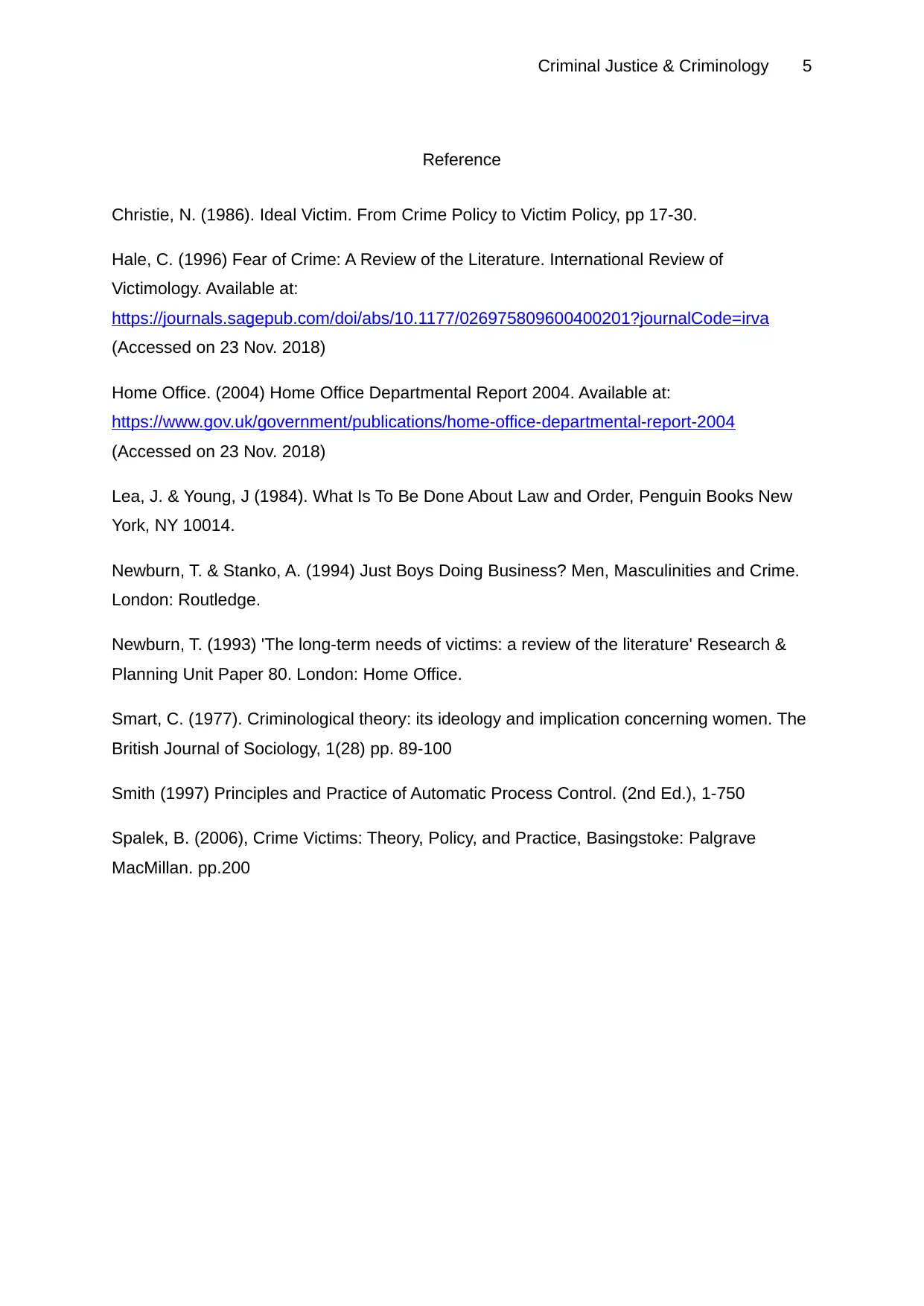
Criminal Justice & Criminology 5
Reference
Christie, N. (1986). Ideal Victim. From Crime Policy to Victim Policy, pp 17-30.
Hale, C. (1996) Fear of Crime: A Review of the Literature. International Review of
Victimology. Available at:
https://journals.sagepub.com/doi/abs/10.1177/026975809600400201?journalCode=irva
(Accessed on 23 Nov. 2018)
Home Office. (2004) Home Office Departmental Report 2004. Available at:
https://www.gov.uk/government/publications/home-office-departmental-report-2004
(Accessed on 23 Nov. 2018)
Lea, J. & Young, J (1984). What Is To Be Done About Law and Order, Penguin Books New
York, NY 10014.
Newburn, T. & Stanko, A. (1994) Just Boys Doing Business? Men, Masculinities and Crime.
London: Routledge.
Newburn, T. (1993) 'The long-term needs of victims: a review of the literature' Research &
Planning Unit Paper 80. London: Home Office.
Smart, C. (1977). Criminological theory: its ideology and implication concerning women. The
British Journal of Sociology, 1(28) pp. 89-100
Smith (1997) Principles and Practice of Automatic Process Control. (2nd Ed.), 1-750
Spalek, B. (2006), Crime Victims: Theory, Policy, and Practice, Basingstoke: Palgrave
MacMillan. pp.200
Reference
Christie, N. (1986). Ideal Victim. From Crime Policy to Victim Policy, pp 17-30.
Hale, C. (1996) Fear of Crime: A Review of the Literature. International Review of
Victimology. Available at:
https://journals.sagepub.com/doi/abs/10.1177/026975809600400201?journalCode=irva
(Accessed on 23 Nov. 2018)
Home Office. (2004) Home Office Departmental Report 2004. Available at:
https://www.gov.uk/government/publications/home-office-departmental-report-2004
(Accessed on 23 Nov. 2018)
Lea, J. & Young, J (1984). What Is To Be Done About Law and Order, Penguin Books New
York, NY 10014.
Newburn, T. & Stanko, A. (1994) Just Boys Doing Business? Men, Masculinities and Crime.
London: Routledge.
Newburn, T. (1993) 'The long-term needs of victims: a review of the literature' Research &
Planning Unit Paper 80. London: Home Office.
Smart, C. (1977). Criminological theory: its ideology and implication concerning women. The
British Journal of Sociology, 1(28) pp. 89-100
Smith (1997) Principles and Practice of Automatic Process Control. (2nd Ed.), 1-750
Spalek, B. (2006), Crime Victims: Theory, Policy, and Practice, Basingstoke: Palgrave
MacMillan. pp.200
1 out of 5
Your All-in-One AI-Powered Toolkit for Academic Success.
+13062052269
info@desklib.com
Available 24*7 on WhatsApp / Email
![[object Object]](/_next/static/media/star-bottom.7253800d.svg)
Unlock your academic potential
Copyright © 2020–2025 A2Z Services. All Rights Reserved. Developed and managed by ZUCOL.